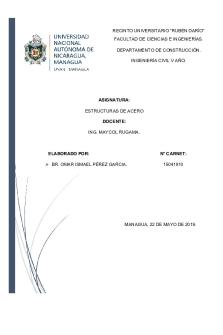SET 2 - Omar Eldakar PDF

| Title | SET 2 - Omar Eldakar |
|---|---|
| Course | Biology II/Lab |
| Institution | Nova Southeastern University |
| Pages | 5 |
| File Size | 58 KB |
| File Type | |
| Total Downloads | 10 |
| Total Views | 165 |
Summary
Omar Eldakar...
Description
SET 2 Chromatid a complex of DNA and protein.
Cohesin complex of proteins holding replicated chromosomes together
Diploid 2n - somatic cells
Haploid n - sex cells or Gametes
Karyotype the particular array of chromosomes of an organism
Mitosis Division of the nucleus. results in daughter cells with identical DNA.
Cytokinesis Division of the cytoplasm, cleavage of the cell into equal halves
Meiosis is a special division that can produce sperm and egg cells.
Prokaryotic cells the genome consists of a single circular DNA molecule.
Eukaryotic cells the genome consists of a number of DNA segments or linear chromosomes.
Somatic cells (nonreproductive cells) have two sets of chromosomes.
Gametes (reproductive cells: sperm and eggs) have half as many chromosomes as somatic cells.
Replicated chromsomes are connected to each other at their kinetochores
sister chromatids 2 copies of the chromosome within the replicated chromosome
Interphase includes G1 phase ("first gap"), S phase ("synthesis"), G2 phase ("second gap")
Interphase makes up 90% of the cell cycle
G1 phase gap one - growth by synthesizing proteins and producing organelles,
S phase DNA synthesis - chromosomes duplicated
G2 phase
gap two - growth by synthesizing proteins and producing organelles in preparation for M phase. The chromosomes undergo condensation, Centrioles (microtubule-organizing centers) replicate and one centriole moves to each pole.
Prophase most complex, Nucleolus disappears, Chromosomes condense, Spindle begins to form, Centosomes move to opposite poles, Asters around centrioles in animal cells
Prometaphase Nuclear membrane disappears, Chromosomes condense even more, Spindle completed, Asters around centrioles in animal cells, kinetichores mature and attach to spindle microtubules.
Metaphase The chromosomes are all lined up at the metaphase plate, Centomeres begin to divide
metaphase plate an imaginary structure at the midway point between the spindle's two poles.
Anaphase Removal of cohesin proteins causes the centromeres to separate, Microtubules pull sister chromatids toward the poles, The microtubules shorten by depolymerizing at their kinetochore ends
Telophase spindle apparatus disassembles nuclear envelope forms around each set of sister chromatids, chromosomes begin to uncoil, nucleolus reappears in each new nucleus
in animal cells - constriction of actin filaments produces a
cleavage furrow
in plant cells - plasma membrane forms a ______ between the nuclei cell plate
Bacteria divide by binary fission
binary fission the single, circular bacterial chromosome is replicated, replication begins at the origin of replication and proceeds bidirectionally, new chromosomes are partitioned to opposite ends of the cell, a septum forms to divide the cell into 2 cells
cell cycle control system The sequential events of the cell cycle are directed by this, regulated by both internal and external controls
The three checkpoints: G1/S checkpoint, G2/M checkpoint, late metaphase (spindle) checkpoint
cyclins proteins produced in synchrony with the cell cycle, regulate passage of the cell through cell cycle checkpoints
cyclin-dependent kinases (Cdks) enzymes that drive the cell cycle
anaphase-promoting complex (APC) the signal for anaphase to proceed is transmitted through
platelet-derived growth factor (PDGF) triggers cells to divide during wound healing
Cancer is a failure of cell cycle control.
tumor-suppressor genes prevent the development of many cells containing mutations
proto-oncogenes some encode receptors for growth factors, some encode signal transduction proteins...
Similar Free PDFs

SET 2 - Omar Eldakar
- 5 Pages

SET 9 - Omar Eldakar
- 9 Pages

SET 4 - Omar Eldakar
- 5 Pages

Omar Perez Garcia
- 6 Pages

Articulo Edgar Omar (IMPC)
- 8 Pages

Os Rubayat, Omar Khayyan
- 36 Pages

Omar Rodriguez Factorización
- 2 Pages

1. Guerrero OMAR admin pública
- 110 Pages

Factura de omar - mariquita
- 1 Pages

Problem set 1-2
- 7 Pages

SET 2 - Chris Blanar
- 18 Pages

LS Problem Set 2
- 4 Pages

Problem set chapter 2
- 4 Pages

Problem Set 2
- 4 Pages

Problem set 2
- 1 Pages
![[ Cobecon ] Problem Set 2](https://pdfedu.com/img/crop/172x258/og2v19l9dy24.jpg)
[ Cobecon ] Problem Set 2
- 3 Pages
Popular Institutions
- Tinajero National High School - Annex
- Politeknik Caltex Riau
- Yokohama City University
- SGT University
- University of Al-Qadisiyah
- Divine Word College of Vigan
- Techniek College Rotterdam
- Universidade de Santiago
- Universiti Teknologi MARA Cawangan Johor Kampus Pasir Gudang
- Poltekkes Kemenkes Yogyakarta
- Baguio City National High School
- Colegio san marcos
- preparatoria uno
- Centro de Bachillerato Tecnológico Industrial y de Servicios No. 107
- Dalian Maritime University
- Quang Trung Secondary School
- Colegio Tecnológico en Informática
- Corporación Regional de Educación Superior
- Grupo CEDVA
- Dar Al Uloom University
- Centro de Estudios Preuniversitarios de la Universidad Nacional de Ingeniería
- 上智大学
- Aakash International School, Nuna Majara
- San Felipe Neri Catholic School
- Kang Chiao International School - New Taipei City
- Misamis Occidental National High School
- Institución Educativa Escuela Normal Juan Ladrilleros
- Kolehiyo ng Pantukan
- Batanes State College
- Instituto Continental
- Sekolah Menengah Kejuruan Kesehatan Kaltara (Tarakan)
- Colegio de La Inmaculada Concepcion - Cebu